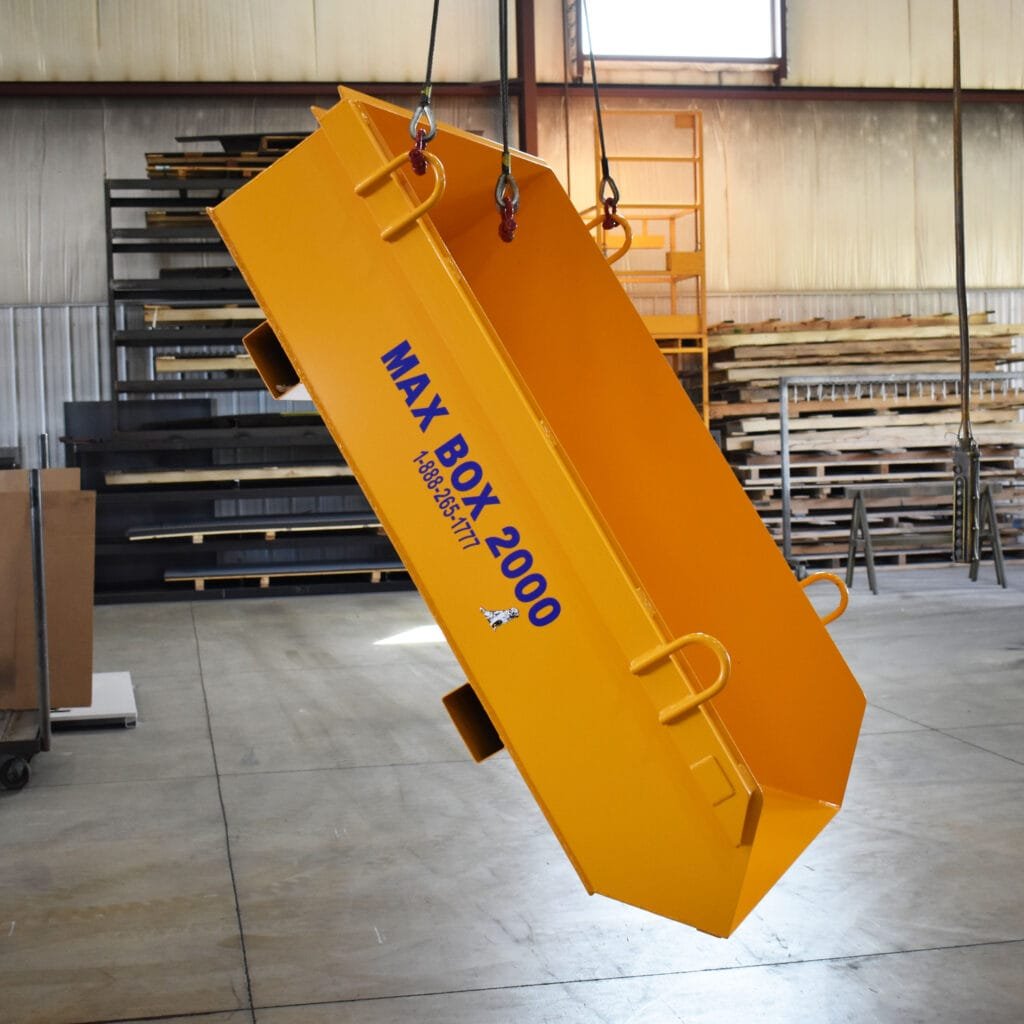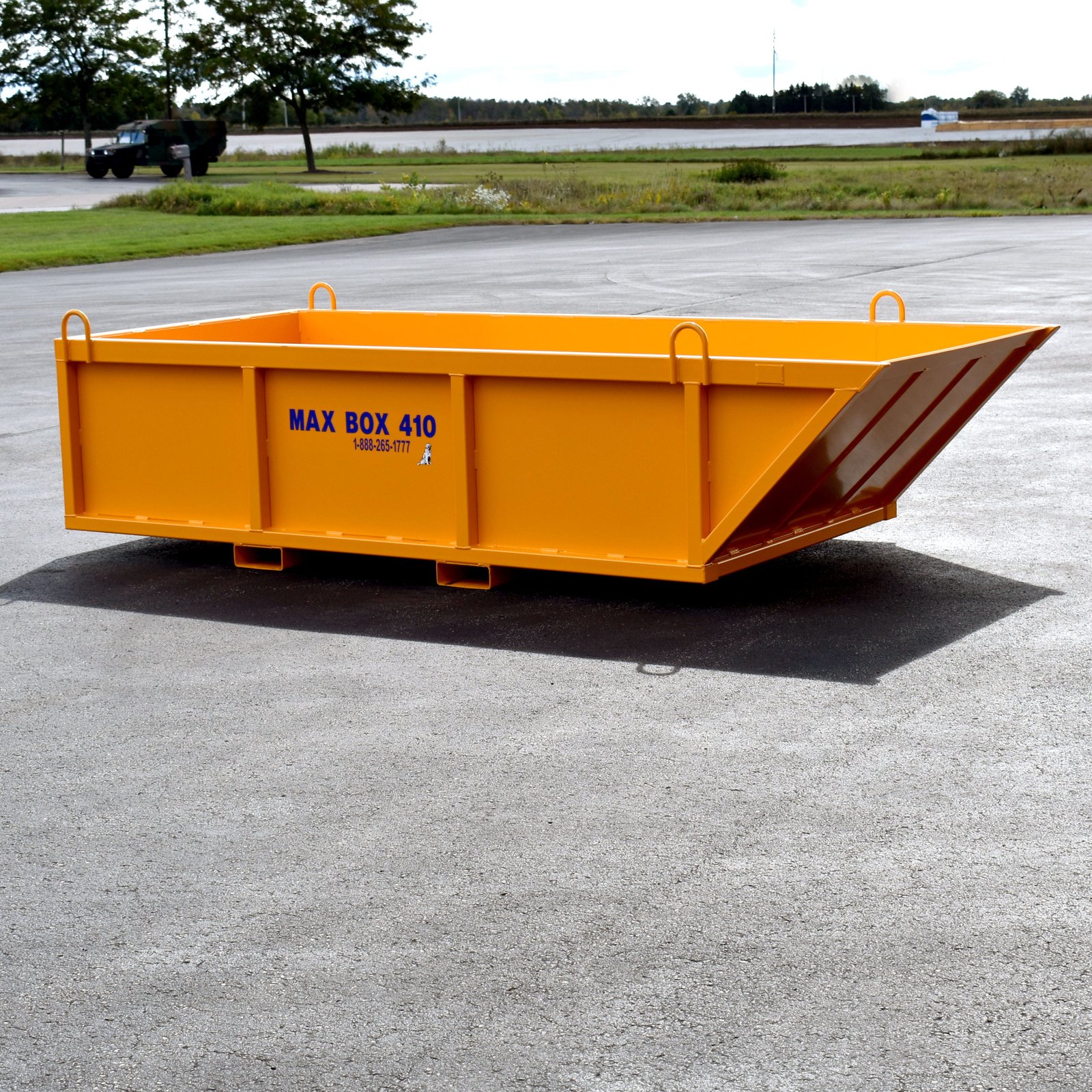Keeping materials moving efficiently is one of the biggest logistical challenges on any job site. Whether you’re working on a commercial build or managing warehouse operations, the constant movement of debris, tools and raw materials adds pressure to remain safe while staying on schedule.
Unfortunately, slow, disorganized material handling delays workflows, creates clutter, and increases the risk of injuries. That’s why more operations are turning to dump box skip pans. These heavy-duty containers allow crews to collect, lift and dump materials with a forklift or crane, eliminating the need for repetitive manual hauling.
This guide explains how dump boxes or skip pans work and how they fit into broader material transport solutions that help keep your job site efficient.
What Are Dump Box Skip Pans?
Dump box skip pans are steel containers that hold and move bulk materials like sand, gravel, dirt and roofing debris. Unlike fixed bins or ad hoc containers, skip pans are purpose-built for safe lifting and dumping using mechanical equipment.
Each pan features a reinforced rectangular shape, with fully welded steel sides and a sloped end that simplifies unloading. Built-in lifting lugs at all four corners accommodate crane rigging, while fork pockets or side rails allow transport with a forklift or telehandler. This compatibility enables crews to reach hard-to-access areas, including upper levels or below-grade zones.
Skip pans are available in various sizes and load capacities to suit different job site needs. For example, Lakeshore Industrial’s Max Box line has rated capacities from 1,000 to 10,000 lbs. Each unit is load-tested, certified, and tagged.
Why Material Transport Solutions Matter on Busy Jobsites
Material handling is one of the most frequent tasks on any active work site. Crews are constantly moving supplies while also clearing away debris or demolition waste. When this movement is slow or disorganized, it impacts more than just the task at hand. It can create congestion and even safety hazards that ripple throughout the project.
That’s why investing in proven material transport solutions is a practical decision. Here’s what’s at stake:
- High Volume of Materials: Construction and industrial sites handle massive quantities of material daily. Without high-capacity transport tools, these volumes can overwhelm labor crews and slow progress.
- Safety Concerns: Manual hauling increases the risk of sprains, overexertion, and trips. Replacing that with mechanical lifting helps reduce site injuries and protect workers.
- Site Organization: Contained transport prevents clutter from accumulating. Skip pans help keep traffic paths clear and the site more navigable.
- Productivity and Cost: Time spent hauling materials by hand is time not spent on skilled work. Efficient transport systems let your crew focus on tasks that move the project forward.

Improving Jobsite Efficiency With Dump Box Skip Pans
Dump boxes or skip pans make a measurable impact on improving jobsite efficiency. Their high load capacity reduces the trips required to move material across the site. Instead of relying on multiple wheelbarrow runs or hauling with small containers, one skip pan can carry several cubic yards of debris or supplies in a single lift.
This alone saves valuable time. A crane or forklift can position a skip pan directly where needed, fill it quickly, then transport and unload it in seconds. There’s no need for excessive handling or multiple touchpoints.
Because skip pans are compatible with cranes and telehandlers, they can also reach areas that traditional vehicles can’t, such as rooftops or confined sites. That access helps crews move material in and out without delay, even on challenging or confined jobsites.
By reducing bottlenecks and minimizing travel time, skip pans support a smoother, faster workflow from start to finish.
Safer Handling and Less Manual Labor
Efficiency on a job site means more than moving materials quickly. It also means doing it safely. Repetitive lifting, pushing, and carrying heavy loads remain among the most common sources of injury on active sites. These tasks are not only time-consuming but also physically demanding and often hazardous.
While skip pans help speed up transport, they also directly affect construction site safety, reducing physical strain on your crew and minimizing preventable accidents. Using dump boxes shifts the burden from workers to machines. Instead of hauling debris by hand, crew members load materials directly into the pan, and a crane or forklift handles the lift.
That single change in process significantly lowers the risk of injuries and fatigue-related incidents. It also clears pathways, since fewer workers are moving back and forth with carts or wheelbarrows, reducing the chance of slips or blocked routes.
Just as important, reducing manual material handling frees up your team to focus on higher-skill tasks. Workers who aren’t tied up with labor-intensive hauling can stay on schedule and maintain a better pace throughout the day.
Safety and Compliance Considerations
Because skip pans function as “below-the-hook” lifting devices, they must meet strict safety standards. High-quality dump box skip pans like Max Box are engineered to comply with ASME B-30-20 and relevant OSHA regulations. They also come labeled with a serial number and tagged with their working load limits to ensure safe operation at the rated capacity.
When used as intended, certified skip pans can significantly improve productivity while reducing the risks of equipment failure, injury, or noncompliance.
Cleaner Jobsites, Fewer Spills
A clean worksite supports clearer movement paths and a smoother workflow. Dump box skip pans make that possible by keeping loose materials contained during transport and storage, which is essential in maintaining high construction site safety standards.
Instead of leaving debris scattered across active zones, skip pans can be placed where cleanup is needed. Workers load material directly into the pan, minimizing the need for temporary piles or uncontained waste. Once full, it can be quickly removed using a forklift or crane.
This process reduces the time spent on secondary cleanup tasks. It also keeps walkways and work areas free of obstructions, lowering the risk of accidents or equipment interference.
Moreover, the solid steel design prevents spills during lifts and transport. Material stays in place until safely dumped, even when working across uneven surfaces or elevated positions. For busy crews and safety officers alike, skip pans offer a reliable way to maintain a more organized job site.
Versatility in Construction and Industrial Applications
Dump boxes or skip pans are used across various industries that need dependable solutions for moving heavy or loose materials. With forklift pockets and crane lift points built into each unit, skip pans also support horizontal and vertical handling. This allows teams to remove material from upper floors, trenches or tight corners where larger equipment can’t reach.
Below are several industries where skip pans support safer and more efficient material handling:
Construction and Demolition
During demolition, crews use dump boxes to contain rubble as it’s removed from upper floors or enclosed areas, minimizing the need for manual carry-down or chute systems. On construction sites, skip pans help move materials like gravel, roofing waste or offcuts away from active zones to keep the site clear and accessible.
Utilities
Space is often limited in utility work, and excavation spoil must be cleared immediately. Skip pans allow crews to load soil, old piping or damaged infrastructure components immediately, keeping work zones clear and reducing the impact on surrounding areas.
Infrastructure and Civil Engineering
Skip pans efficiently handle bulk materials in large-scale projects like bridge construction or tunnel excavation. Their flexibility reduces equipment congestion and enables steady material flow, which supports project pacing and crew coordination.
Heavy Manufacturing
Manufacturing operations rely on skip pans to manage high-density scrap without slowing production. Positioned near machines or cutting stations, the pans collect excess material and are removed by crane or forklift once full. This limits floor congestion and reduces the risk of tripping or forklift traffic issues in active work zones.
How Lakeshore Industrial’s Custom Dump Boxes / Skip Pans Help
Busy job sites demand equipment that helps crews stay productive and safe. Lakeshore Industrial’s Max Box dump box/skip pans are designed to meet those demands head-on.
The Max Box isn’t limited by flat ground or open space. Its compatibility with cranes and telehandlers allows you to move materials vertically, across tight lots or into locations a dump truck can’t reach. This gives you more control over how and when materials are placed or removed, especially in high-density or multilevel worksites.
Each unit is built to take abuse without breaking pace. Backed by full load testing and ASME B30.20 certification, every Max Box arrives jobsite-ready, already proven for performance. For operations that can’t afford downtime, it’s a solution you can put to work on day one.
Find the Right Dump Box or Skip Pan for the Work Ahead
Dump boxes or skip pans support cleaner, safer job sites and help crews stay productive. They contribute to a more controlled and efficient work environment by by reducing manual hauling and keeping debris contained.
Choosing a skip pan built for this kind of performance matters. With certified load ratings, rugged construction and compatibility with the equipment already on site, the right pan helps your team stay focused and avoid delays.
Planning your next project or upgrading equipment? The Max Box delivers reliable material handling that keeps work moving. Contact Lakeshore Industrial to find the right skip pan for your needs.


